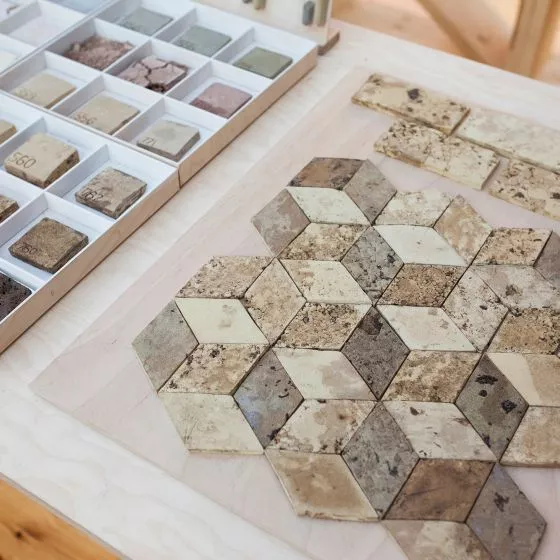Chapter II
Disorders of perception
In the context of modern technology.
I mentioned above that in his books the architect describes mainly contemporary architecture. Key in the theorist's conception, it seems, is the understanding of space as the components of several elements that have an equal influence on our perception. The timing of Pallasmaa's conclusions is not without significance. The period is the 1990s, the years of the introduction of new technological solutions to design. Sensory issues turned out to be related to this phenomenon. The abandonment of the use of natural raw materials and the introduction of modern technologies, including advertising and screens, made architecture unreal. Fin puts forward the thesis that:
(...) buildings have turned into visual products detached from existential depth and sincerity6.
He questions the use of modern materials that imitate natural materials. He considers the material's lack of signs of aging unfavorable - we are unable to infer its origin or history. Pallasmaa believes that designers - when analyzing the influence of media on the viewer in their designs - are limited only to impressions corresponding to the sense of sight. In his reflections, he even points to the inhuman nature of modern cities. Through the dominance of photographs in publications, or on the Internet, architects, instead of exploring how they can influence the viewer through all the senses, limit themselves to framing and aesthetics. Pallasmaa repeatedly cites the words of Susan Sontag, who analyzed the impact of photography on the perception of the world in her work "On Photography." The theoretician also notes that flattening does not apply only to architecture, but also to other fields of art:
These works appeal to the intellect and conceptual structures, instead of referring to the senses and differentiated bodily responses7.
The book "Thinking Hand, " however, is not just a consideration of haptics. Juhani Pallasmaa, in connection with questions about the condition of contemporary architecture, analyzes the quality of an architect's work. Undoubtedly, the changes seen in recent years are related to the introduction of computer-aided design into the work of designers. In the context of these considerations, the theorist returns to the topic of the senses. He stresses how important the preparation of hand drawings and mock-ups still is in the work of many architectural offices. Material exploration is still not losing its value. As an example, Juhani Pallasmaa cites Alvar Aalto's attempts to bend wood or Antoni Gaudi's inverted structural experiments8. Pallasmaa asks questions about perceptions of things, including what the architect's work itself is. At the same time, he stresses that he is not opposed to progress, resulting from the use of modern technology. It would be necessary to prudently analyze the limitations that have emerged with this phenomenon. Such actions would allow for conscious use of the tool. The theoretician cites the words of Finnish designer Tapio Wirkkala:
The designer's task is to work in harmony with the material. The craftsman has the advantage that at every stage of work the material is in his hands, he can feel it and command it. In industry, the material is constantly subject to some pre-planned law and machinery, and once the work has begun, it is difficult to make changes9.
Naive reliance on computer visualization simulation, for example, leads to unfavorable decisions in the context of material selection as well. With the blurring of the distinction between fiction and reality, we are seeing a return to craftsmanship:
We now desire an architecture that would bring us back to the concrete realities of our physical and material world10.
The designer goes back to traditional construction with his analysis, comparing it to the intuitive shaping of a nest by animals using body movements. On this topic, he presented a lecture at the What Can We Learn form Living Swarming Insects conference organized by the Institute of Living Technology in Venice in 2009. A Polish translation of this lecture was presented in the journal Self-Portrait in 2016. The theorist notes a kind of amnesia in architectural education. Most studies omit issues related to braided structures, starting descriptions with tectonic structures. He also looks for correlations between animal architecture and that originally built by humans. In the context of material considerations, he emphasizes that initially humans used natural, readily available ones in their constructions. He compares the buildings of American Indians to the clay forms shaped by certain species of swallows. Pallasmaa also notes that animal architecture is characterized by a clear purpose - the need for survival. He mentions that humans have the ability to come up with ideas whose consequences are not thought out:
This temporal emancipation from under the primacy of the logic of survival allows us to erect structures that are irrational from the point of view of the real needs of life11.
From these words we can infer that buildings are often a reflection of ideas without a thorough analysis of the form and materials used. A separate reflection could also apply to modern plastics and the issue of ecology. It is also worth quoting the statement "the discreet wisdom of the body" - after all, originally architecture was created taking into account the needs of the whole body.
The theorist also refers to the book "Feeling Architecture" written in 1959 by Steen Eiler Rasmussen. The architects' publications contain many common conclusions. Rasmussen, like Juhani Pallasmaa, believes that both art and architecture should not be explained, but more felt. In the opening lines of his piece, he compares a designer to a theater producer who needs to know the behavior of his actors in order to get the most out of them. It is just as important to know the cultural context and the audience when designing
If we believe that the purpose of architecture is to create a framework for human life, then the way we live and move determines the form of the rooms in our homes and the relationships between them.12
As for Pallasma's criticism of oculocentrism, in his book "Feeling Architecture," the author does not emphasize the differences between the senses, focusing his attention on the result of perception. Moreover, he devotes three of the ten chapters of his book to the sense of sight.
In the chapter titled "Texture," reaching back to craftsmanship, the architect analyzes various materials such as wicker baskets and ceramics. This section is accompanied by poetic descriptions, comparing the rough form of a basket, which emphasizes its structure, with the smooth form of a fired clay vessel. Rassmussen emphasizes the importance of knowing the properties of the materials used. He believes that the form, the shape of a given raw material should emphasize its character, not pretend to be something else.
He cites Frank Lloyd Wright and the famous House by the Waterfall as an example . Frank Lloyd Wright was one of the proponents of reinforced concrete structures, instead of smoothing these elements, he gave them deep relief. The building is considered one of the more perfect examples of architecture in terms of the materials chosen, among other things. The principle of selecting two contrasting raw materials was adopted - those with poor textural effects are recommended to be carved, while those with rich texture are left in their raw form. Steen Eiler Rasmussen emphasizes the importance of lighting in the context of material selection:
Parts that are too brightly lit will annihilate the form; while a shadow that is too deep will make the form not visible from one side13.
Both theorists address the issue of acoustics in their books. Steena Eiler Rasmussen, in the chapter "Hearing Architecture," states that
sounds give us an impression of form and material14.
Before the advent of modern technology, acoustics resulted from the raw materials used and from the form, the shape of a given room, these proportions were very important. The relationship of the creation of architecture and music at that time is very interesting. It was the sound that influenced the shape of the architecture, and the music was determined by the acoustic conditions of the rooms:
The priest would start with a recitation and then let the voice rhythmically drop off and rise; the main syllables were clearly audible and then faded out, while the next syllables followed as modulations. In this way, the chaos of overlapping sounds was eliminated. The text became a living song in the church, which transformed the great edifice into a musical experience in a soul-penetrating way. Such, for example, are the Gregorian chants composed specifically for the former St. Peter's Basilica in Rome15.
The use of an electronic sound system has eliminated for us the limitations of this relationship, but it has also made the compromise between sound and architecture so familiar to us from church buildings disappear.
Another important artist who cannot fail to be mentioned in the context of the issues I've discussed is Walter Gropius. The architect, who lived from 1883 to 1969, was the founder of the Bauhaus, an art and craftcollege. At this school, special attention was paid to the study of social issues, the relationship between psychology, biology and technology, and the executive knowledge of future designers. In his book "The Fullness of Architecture," Gropius reflects on the importance of creating buildings in the modern world. His considerations apply to the profession as well as to education at the same time. He stresses that feelings are as important as the technical components of buildings
In essence, I consider the psychological issues to be fundamental and primary, while the technical components of design are the intellectual props that allow the intangible to become a reality through the tangible16.
Interestingly, the architect refers to the activity of perception. He considers it fundamental to understand how this activity takes place, and states that impression comes from us and depends largely on our sensitivity.
Gropius, working during the industrial era, also addresses the impact of machines on the way designers work.
The sum total of the incredible transformations that have taken place during the last half-century of industrial development has transformed human life ... every modern thinking person seeks an answer to the question of how much such staggering scientific progress is actually worth. We relish the achievements of technology and inventions that enable faster transportation. But what do we do with the time we save? "17
This is another architect who notes the importance of understanding and mastering the operation of machines so that they serve to streamline work, rather than replace creative action.
















